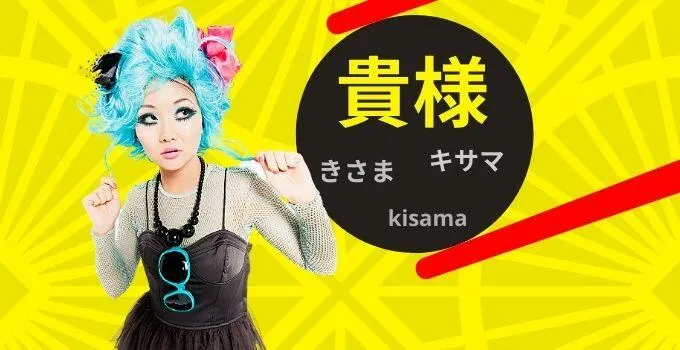In this article we’ll be discussing the Japanese word kisama in great detail. We’ll cover what it means (of course), and also how to write it, use it, and where it comes from.
It’s a somewhat strange word in the Japanese language, with a long and varying history, so it’s well worth the time to understand all of its unique details.
First, let’s start with the really simple stuff…
What does kisama mean in Japanese?
Kisama is a pronoun meaning “you.” A long time ago it was a term of respect, however today it is extremely rude, carrying a sense of contempt. It is usually only heard in Japanese media and not used in everyday life.
How to write kisama
Kisama can be written in four ways, as many Japanese words can.
First, you can just write it as we have been, in romaji: kisama. Then in hiragana as きさま or katakana as キサマ. Finally, there’s the kanji way of writing it, 貴様.
The first kanji has a few meanings. It can mean “expensive,” “precious,” “aristocratic,” or “esteemed.” The character 貴 is simplified from 䝿 and came to Japan from Middle Chinese.
The second kanji is just a respectful suffix.
The meaning of kisama today
To keep it really simple, kisama is just a pronoun meaning “you.”
That’s the easy part. Now for the more complex usage.
In some sense, it’s considered a very, very rude word. It carries a lot of contempt for the person being spoken to. However, at the same time, it’s kind of antiquated.
Nowadays, you’ll see kisama written in manga, or spoken angrily in anime. Because of this, if you were to say it in real life you probably wouldn’t offend anyone.
In fact, instead of showing contempt for the other person, you’ll just make yourself seem like a completely uncool lose. More specifically, you’ll sound like an otaku, aka a big nerd.
Imagine saying, in English, “You scurrilous fool!” Like, sure, that’s not a nice thing to say to someone, I guess, but really you’d just sound like a neckbeard loser if you tried to insult someone that way.
So, in real life today, kisama would be considered “extremely cringe.”
However, you may actually hear this word in a non-contemptuous way if you were to watch period pieces dealing with life from the seventeenth to nineteenth century. Why is that?
The historical meaning of kisama
There’s some mystery about the origins of this word, with at least three different origin stories. That said, one thing experts are pretty certain about is that kisama was a deliberately created word.
It may have started as a shortened for of kimi-sama, 君様. That first kanji is today most familiar to Japanese learners as the word for “you,” but can also mean “lord” or “ruler.”
The second kanji is the respectful suffix. So, basically, the word may have started as translating to “honorable lord.”
The second possibility is that it came from kisho-sama, 貴所様. Kisho is a respectful way to refer to someone else’s residence. And, of course, we have that respectful suffix again.
These two are fairly unlikely explanations for a couple reasons. First, because of the big distinction between the initial kanji used.
Then there’s the fact that kimisama, kishosama, and kisama were all in use at the same time, something that isn’t usually seen.
And, finally, because, in Japanese, when a word loses some of its sounds, it usually also loses its politeness. However, in its initial use kisama was a very polite term.
Finally, we have the possibility that it’s just the combination of ki for “graceful,” and that all-important suffix again, -sama.
Kisama was created at the very tail end of the Sengoku era as a formal way to address a letter from one samurai to another.
Starting in the Edo period, kisama made its way into everyday speech.
In the first half of the Edo period, that speech was still relegated mostly to the samurai class, although there’s strong evidence that it was used by people of lower status to speak to those above them.
In the second half of that period, the term started to lose its politeness.
First, it started to be used for people of equal status, and then gradually it was used to speak down to someone.
By the Meiji period the politeness was completely gone and was used only derogatorily and with contempt.
Unfortunately, my research did not tell me when the word moved out of colloquial speech and made itself merely a fixture of media language.
Other options instead of kisama
A close cousin of kisama is the word temee, written 手前, although it’s more common to see it written てめえ.
Those kanji are “hand” and “front,” respectively. It’s demeaning, in a way, referring to “you” as “this thing in front of my hand.
This one gets heard a lot in media, but it’s also heard in real life. It’s what you might call “fightin’ words.”
Another word for “you” is omae, written お前, or おまえ. Yup, that’s the same kanji as in temee. This one’s like saying “this person in front of me.”
Again, slightly demeaning. And, yes, that is the honorific o- at the front, but in this case it doesn’t suggest any honor.
While omae is a very rough word, and can definitely be very aggressive with strangers, you’ll hear this word used among friends and even among couples. Take your time learning the nuances of this one.
Finally, let’s talk about anata, usually written あなた. This is a sort of “generic” pronoun for “you.”
You’ll hear it among couples and friends, and old people like to use it with younger people. That said, it’s a bit rude. Not temee-rude, but not nice, depending on the circumstance.
This is another word to be careful with and learn the right context for. Sometimes it’s a very necessary word, but sometimes it’d be ill-advised to use it.
So long, you
That’s all! Now you know how (not) to use “kisama,” and all about its history. And you have a few good options to replace it in your vocabulary when you need a way to get someone’s attention. Good luck out there!

“I’ve lived in Japan on-and-off for the last five years, travelling to (almost) every corner of the Land of the Rising sun. I’ve deepened my love of the language with big hauls from Sapporo book stores, by chatting in Shinjuku coffee shops, drinking in Osaka “snack bars,” exploring distant Okinawan islands, and hitching rides with monks in Aomori. Japanese is a wide and deep language, and I’m always eager to dive in deeper.”

